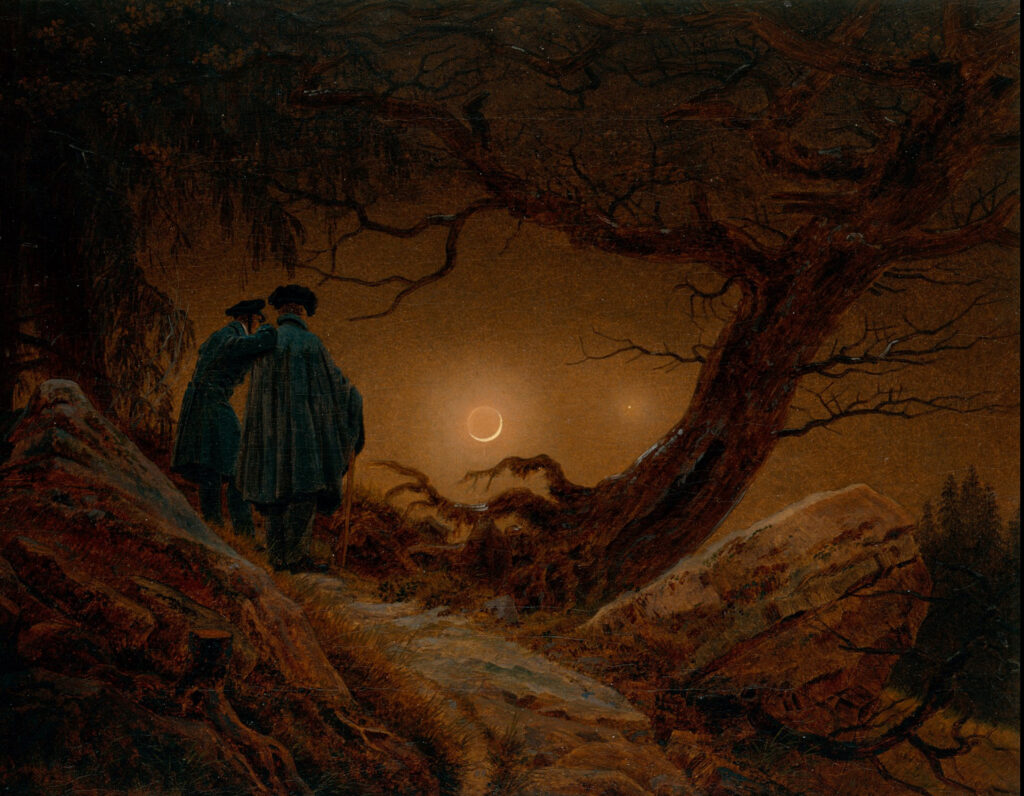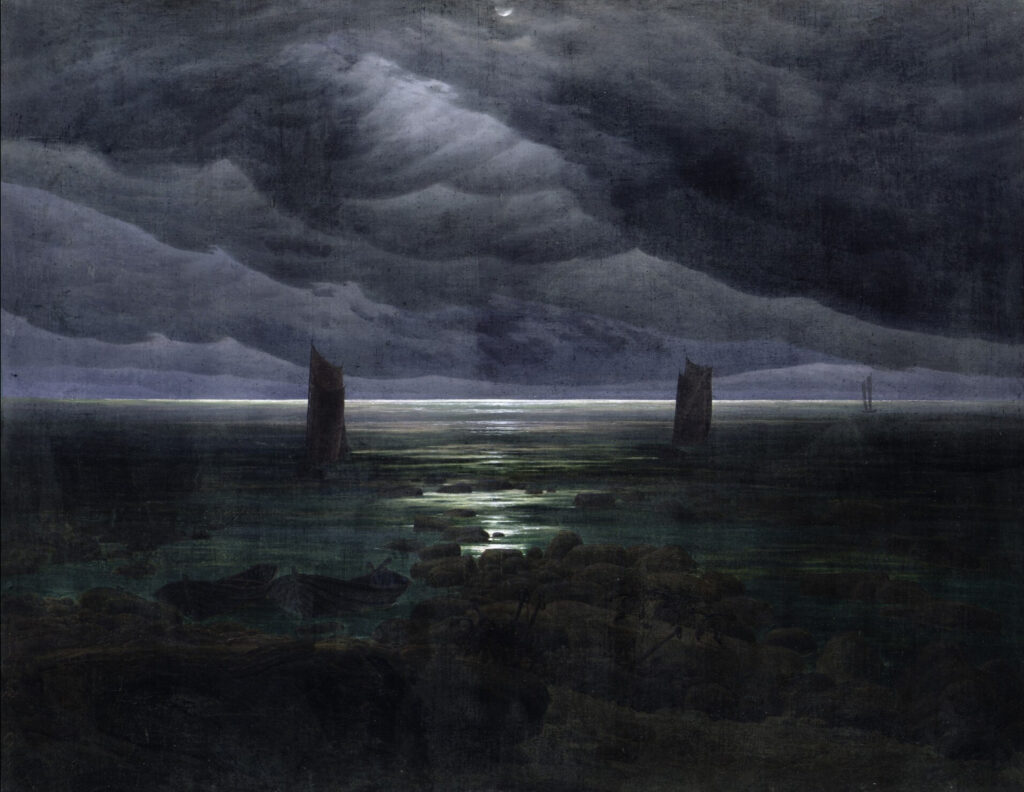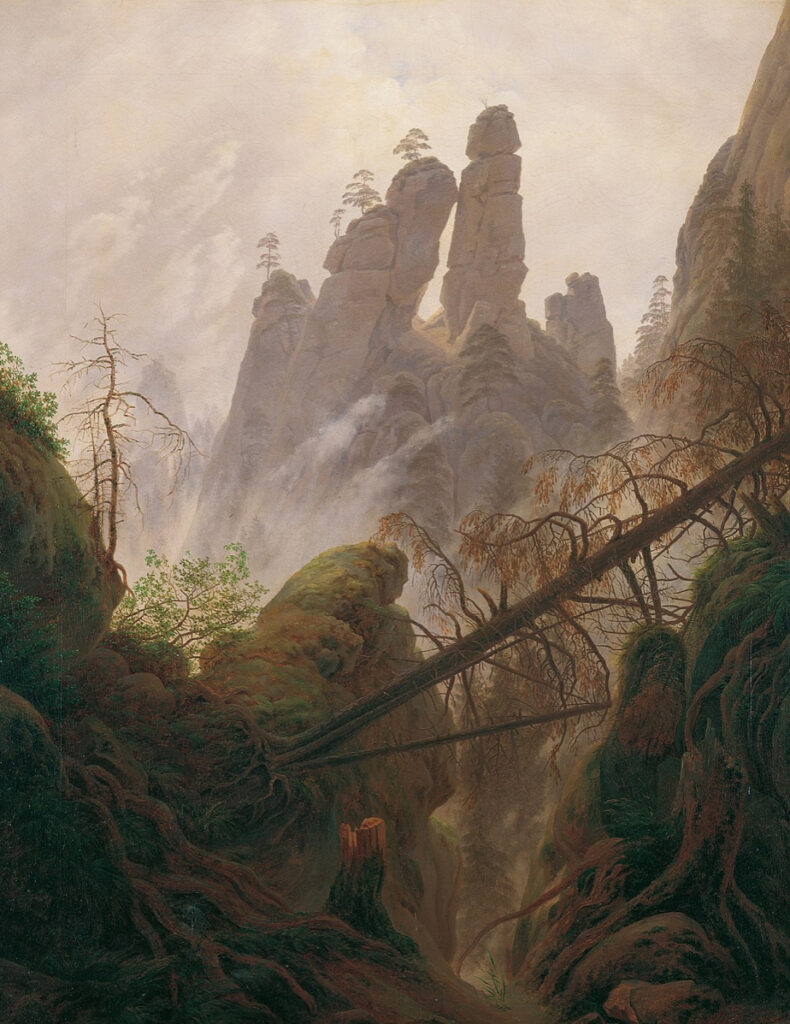ChatGPT:
🌫️ Caspar David Friedrich: The Painter of the Sublime and the Unknown
Caspar David Friedrich (1774–1840) remains one of the most significant painters of German Romanticism, a movement that sought to counter Enlightenment rationalism with emotion, spirituality, and a deep connection to nature. His most famous painting, “Wanderer Above the Sea of Fog” (1817), has become an iconic representation of the solitary, introspective individual confronting the vastness of the world. This painting serves as a visual metaphor for both the human struggle for understanding and Germany’s evolving national identity.
🏔️ Friedrich’s Artistic Philosophy: The Sublime and the Infinite
Friedrich’s landscapes are not just about nature but about human experience—they depict not what is seen but what is felt. His work aligns with the Romantic notion of the sublime, a concept that emphasizes the overwhelming power of nature and its ability to evoke awe, fear, and introspection.
🔹 Fog, emptiness, and obscured details play a crucial role in his paintings. Instead of offering a clear view, Friedrich forces the viewer to confront uncertainty, reflecting the limits of human perception.
🔹 His art stands in contrast to Enlightenment ideals of logic and reason. While the 18th-century Enlightenment valued scientific observation, Friedrich’s work embraced emotion, spirituality, and the unknown.
🔹 He rejected classical and academic traditions, opting for personal expression and introspection. His landscapes are not idyllic or decorative but meditative and deeply personal.
🔸 Early Sepia Drawings: Friedrich’s early work consisted of sepia-toned landscapes, where moody desolation and sparse compositions conveyed deep emotional depth.
🔸 Crucifixes in Nature: Many of his landscapes feature solitary crucifixes, blending religious contemplation with natural settings. These works reflect Germany’s struggles with faith, nationalism, and modernity.
🔸 The Monk and the Sea: One of his most famous paintings, “Monk by the Sea” (1808–10), features a lone figure dwarfed by an empty, infinite seascape. Originally, Friedrich included boats on the horizon but later removed them, intensifying the sense of existential isolation. This painting has been compared to Mark Rothko’s color fields, as both create an overwhelming sense of spiritual emptiness.
🔸 German Nationalism and Political Undertones: Friedrich’s art has been politically appropriated at different points in history. In the 20th century, his work was admired by Adolf Hitler, casting a shadow over his legacy. However, today, it is reclaimed as an expression of individual freedom and the search for meaning.
🔸 Climate Change Relevance: Friedrich’s landscapes, often marked by war-torn trees and turbulent skies, feel relevant today as climate change reshapes our world. The exhibition suggests that his art is a warning, a meditation on the fragility of nature.
🛤️ The Journey into the Unknown: Friedrich’s Romantic Legacy
Friedrich’s work was not always celebrated. His career declined in his later years, and by the time of his death, he was largely forgotten. However, in the 20th and 21st centuries, his art was rediscovered and celebrated as a precursor to modern existentialism.
🔹 Romantic Individualism: Friedrich’s art aligns with the Romantic belief that true freedom is not external but internal, achieved through moral and aesthetic self-discovery.
🔹 The Limits of Reason: Unlike Enlightenment thinkers who believed rationality could explain everything, Friedrich embraced mystery and uncertainty, suggesting that some truths remain unknowable.
🔹 Erlebniskunst (Art of Experience): Friedrich’s work is not meant to depict nature realistically but to evoke an emotional response—what the Romantics called Erlebniskunst, or the “art of experience.”
🔹 A Legacy of Longing: Friedrich’s paintings are filled with longing—for God, for understanding, for the infinite. His figures, whether monks, wanderers, or solitary observers, gaze into the unknown, just as we do today.
🌍 Final Thoughts: Friedrich’s Relevance Today
Caspar David Friedrich’s art remains as powerful and relevant today as it was in the early 19th century. Whether seen as a meditation on human solitude, a reflection on environmental destruction, or an exploration of national identity, his paintings continue to speak to modern audiences.
Even in a world transformed by technology and globalization, Friedrich’s solitary wanderers and empty landscapes remind us of our own place in the vast, unknowable universe. As we continue to struggle with questions of identity, meaning, and climate crisis, Friedrich’s vision remains hauntingly relevant.
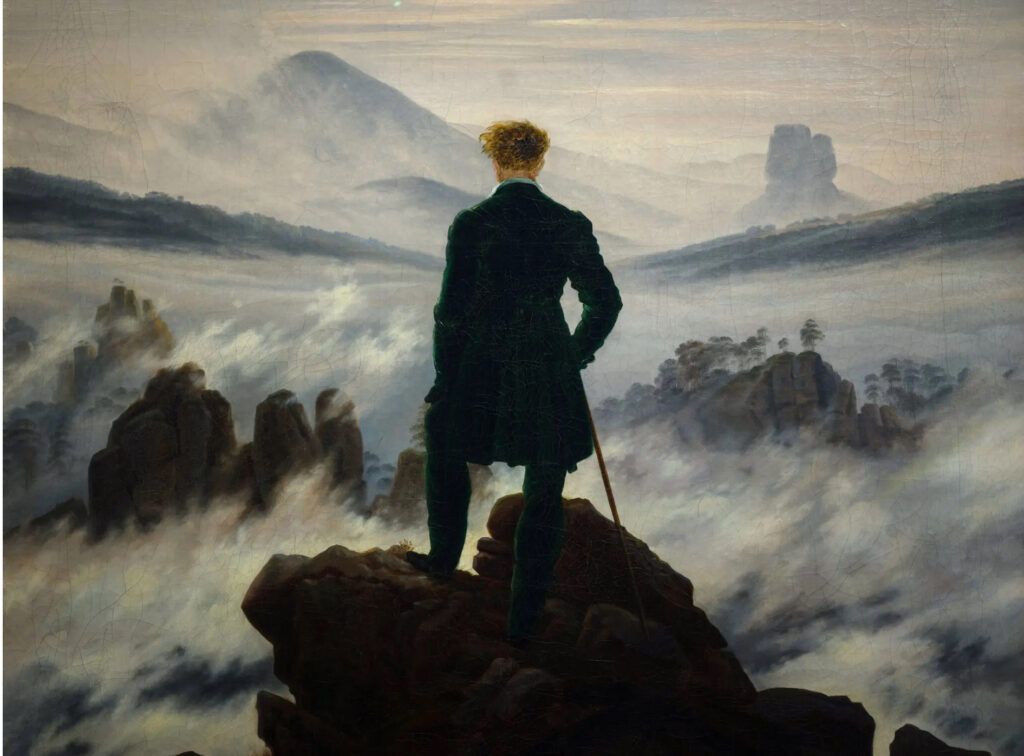
FAQs on Caspar David Friedrich and His Art
- Who was Caspar David Friedrich?
Caspar David Friedrich (1774–1840) was a German Romantic painter known for his melancholic, atmospheric landscapes that explore themes of solitude, nature, and the sublime. His work often features lone figures contemplating vast landscapes, emphasizing the insignificance of humans compared to nature.
- What is Friedrich’s most famous painting?
His most famous work is “Wanderer Above the Sea of Fog” (1817), which depicts a man standing on a rocky outcrop, gazing into a fog-filled landscape. This painting has become an icon of Romanticism, symbolizing introspection and the human struggle to understand the infinite.
- What is the meaning behind “Wanderer Above the Sea of Fog”?
The painting represents existential reflection and the limits of human perception. The fog serves as a metaphor for the unknown, suggesting that true understanding is always out of reach. The solitary figure embodies the Romantic ideal of an individual seeking meaning in nature.
- Why is Friedrich important to art history?
Friedrich revolutionized landscape painting by making nature an expression of human emotion and philosophy, rather than just a scenic background. His work helped shape the Romantic movement and influenced later artists, including the Symbolists, Surrealists, and even modern painters like Mark Rothko.
- What themes did Friedrich explore in his paintings?
His paintings often explore:
• The Sublime: The overwhelming power of nature.
• Solitude and Melancholy: Figures lost in thought, contemplating vast landscapes.
• Spirituality: Religious symbols, such as crosses and monks, in natural settings.
• Nationalism: Some of his works reflect German identity and history.
• The Limits of Human Knowledge: Fog, darkness, and vast spaces symbolizing the unknown.
- How did Friedrich differ from other Romantic painters?
Unlike British painters like J.M.W. Turner and John Constable, who used expressive brushwork and dramatic lighting, Friedrich’s compositions are precisely structured, with calm yet emotionally intense atmospheres. His works often depict figures with their backs turned, emphasizing the viewer’s emotional connection rather than the subject’s identity.
- Why was Friedrich’s art forgotten for many years?
After his death in 1840, his work fell out of favor as Realism and Impressionism gained popularity. In the 20th century, his reputation suffered further because Adolf Hitler admired his paintings, leading to their association with nationalist propaganda. His work was later rediscovered and reinterpreted as deeply personal and philosophical rather than political.
- What is the significance of “Monk by the Sea”?
This painting (1808–1810) features a solitary monk standing before an empty, infinite seascape, evoking feelings of existential loneliness and spiritual contemplation. Originally, Friedrich painted two ships on the horizon but later removed them, heightening the sense of isolation.
- How is Friedrich’s work relevant today?
His art resonates with modern concerns about identity, environmental destruction, and existential anxiety. His portrayal of nature as vast and uncontrollable mirrors contemporary discussions on climate change and humanity’s fragile place in the world.
- Where can I see Friedrich’s paintings today?
Many of Friedrich’s works are housed in German museums, such as:
• Alte Nationalgalerie (Berlin)
• Hamburger Kunsthalle (Hamburg)
• Galerie Neue Meister (Dresden)
His work is also featured in major international museums, including The Metropolitan Museum of Art (New York), which recently hosted a major Friedrich exhibition.
- How did Friedrich influence later artists?
His focus on emotionally charged landscapes influenced Symbolists, Expressionists, and even modern abstract painters. Artists like Mark Rothko admired his use of minimalism and vast, open spaces to evoke deep emotion.
- What is “Erlebniskunst,” and how does it relate to Friedrich?
“Erlebniskunst” means “art of experience” in German. Friedrich’s paintings prioritize the emotional and spiritual impact of a landscape over its realistic depiction, making the viewer feel a personal connection to the scene.
- Did Friedrich paint historical or mythological scenes?
No, Friedrich avoided historical, mythological, or classical themes, which were common in his time. Instead, he focused on landscapes imbued with deep personal and spiritual significance.
- What is the connection between Friedrich and climate change?
His paintings often depict decaying trees, turbulent weather, and human insignificance in nature, themes that resonate today as we face environmental crises. His art can be seen as a warning about nature’s power and our fragile existence within it.
- What techniques did Friedrich use in his paintings?
• Precise, smooth brushwork (unlike the expressive strokes of Turner).
• Muted, atmospheric colors to create emotional depth.
• Strategic use of fog, light, and perspective to evoke mystery and infinity.
• Figures with their backs turned to invite viewers into their contemplation. - What was Friedrich’s personal life like?
Friedrich was a solitary and introspective figure, deeply affected by the early deaths of his siblings. He never achieved great wealth or fame in his lifetime, and he struggled with depression in his later years.
- How does Friedrich’s work compare to the Hudson River School?
While the Hudson River School painters (such as Thomas Cole) depicted grand, untamed American landscapes, Friedrich’s landscapes were often more introspective and symbolic, focusing on personal and existential themes rather than national expansion.
- What is the meaning of crosses and ruins in his work?
Friedrich frequently painted solitary crucifixes, ruined churches, and abandoned cemeteries, symbolizing faith, loss, and the passage of time. These motifs reflect his spiritual struggles and philosophical reflections on mortality.
- How did Friedrich’s background influence his art?
Born in Greifswald (then part of Sweden, now Germany), Friedrich grew up near the Baltic Sea, which influenced his fascination with coastal landscapes and foggy atmospheres. His early training in Denmark exposed him to classical art, but he later rejected it in favor of Romantic individualism.
- What is the future of Friedrich’s legacy?
Friedrich’s work continues to inspire artists, filmmakers, and thinkers. As the world grapples with environmental and existential crises, his vision of humanity’s fragile relationship with nature remains deeply relevant. His paintings are likely to gain even more significance in contemporary discussions on climate, spirituality, and self-discovery.
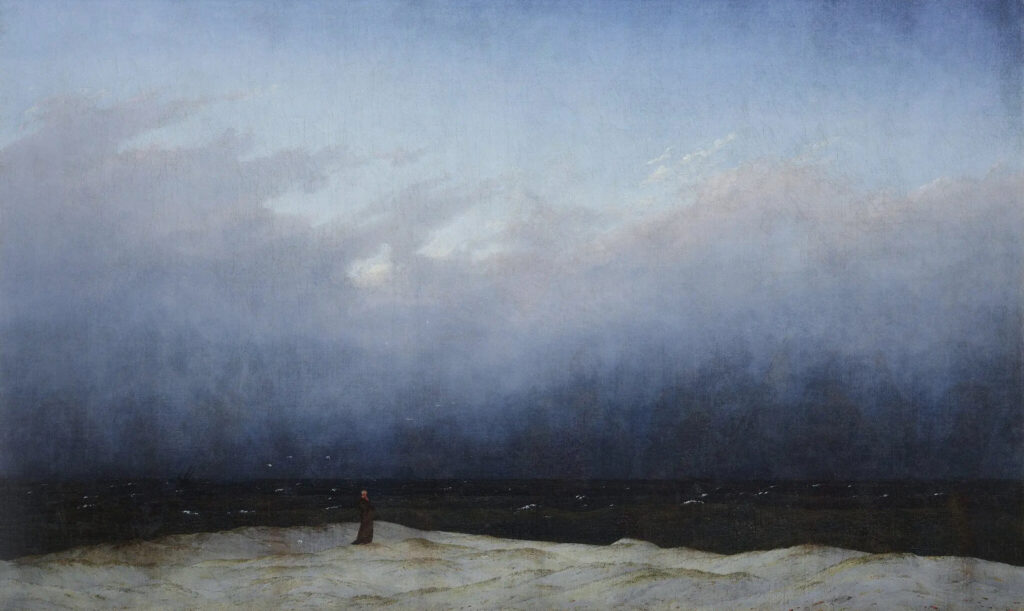
German Romanticism: Origins, Development, and Influences
Origins of German Romanticism
German Romanticism emerged in the late 18th century, as a reaction against the rationalism and order of the Enlightenment. It was deeply influenced by political upheaval, nationalism, and a desire to return to nature and emotion. Unlike the French and English versions of Romanticism, which focused more on individualism or revolution, German Romanticism had a strong spiritual and philosophical component.
Key Historical and Intellectual Influences
1. The Enlightenment (17th–18th Century) – German Romantics rejected the mechanistic and scientific worldview of the Enlightenment, emphasizing emotion, intuition, and the supernatural instead.
2. Kant’s Philosophy – Immanuel Kant’s “Critique of Pure Reason” (1781) argued that reality is shaped by human perception, influencing Romantic ideas about subjectivity and the limits of knowledge.
3. The French Revolution (1789–1799) – Initially inspiring many Romantics with its ideals of freedom and self-determination, the Revolution’s violence later led to a Romantic disillusionment with rational politics.
4. Goethe and Sturm und Drang – Johann Wolfgang von Goethe, Friedrich Schiller, and others developed Sturm und Drang (“Storm and Stress”), a movement that emphasized strong emotions, individual genius, and rebellion against social norms. This laid the groundwork for Romanticism.
Development of German Romanticism
German Romanticism unfolded in two phases:
Early Romanticism (1790s–1810s) – Frühromantik
• Centered in Jena, a university town where philosophers, poets, and artists collaborated.
• Writers like Friedrich Schlegel, Novalis, and Ludwig Tieck emphasized imagination, mythology, and subjective experience.
• Influenced by German Idealism, particularly Fichte and Schelling, who argued that the self and nature are interconnected.
• Early Romantics saw art as a means of achieving transcendence and self-discovery.
Late Romanticism (1810s–1830s) – Hochromantik
• Shifted focus to national identity, history, and folklore, as Germany sought unification.
• Brothers Grimm collected German fairy tales, emphasizing a return to medieval and folk traditions.
• Artists like Caspar David Friedrich used landscape painting to express spirituality, isolation, and the sublime.
• Musicians like Beethoven and Schubert blended intense emotion with national pride.
• A darker, Gothic element emerged, with supernatural themes and eerie landscapes.
Key Themes of German Romanticism
🌲 Nature and the Sublime – Nature was seen as a living, spiritual force, often depicted as mysterious, wild, and awe-inspiring.
💭 Subjectivity and Emotion – Personal feelings, dreams, and the unconscious mind were more important than rational thought.
⚔️ Nationalism and Medievalism – A deep nostalgia for the Middle Ages and Germanic folklore, linked to rising national identity.
🌌 The Supernatural and the Unknown – Many works explored ghosts, dreams, and mystical experiences, emphasizing the limits of human understanding.
🎭 Art as Infinite and Universal – German Romantics believed art should be an endless, evolving process, capable of expressing the deepest truths of existence.
Major Figures and Their Contributions
📖 Literature and Philosophy
• Johann Wolfgang von Goethe – His novel The Sorrows of Young Werther (1774) was a foundational Romantic text, and Faust (1808) explored human ambition and the search for meaning.
• Friedrich Schlegel – A key theorist of Romanticism, he argued that literature should be fragmented, mysterious, and evolving.
• Novalis (Friedrich von Hardenberg) – Emphasized dreams, the mystical, and the union of art and nature. His novel Heinrich von Ofterdingen introduced the Blue Flower, a key Romantic symbol of longing and transcendence.
• Ludwig Tieck – Wrote fairy tales and Gothic stories, blending the medieval past with Romantic ideals.
🖌️ Art
• Caspar David Friedrich – The greatest Romantic painter, known for mystical landscapes, fog, and solitary figures in nature (Wanderer Above the Sea of Fog, Monk by the Sea).
• Philipp Otto Runge – Created symbolic, spiritual landscapes, connecting nature and divine presence.
🎼 Music
• Ludwig van Beethoven – Transformed classical music by making it deeply emotional, personal, and dramatic (Symphony No. 9, Moonlight Sonata).
• Franz Schubert – Composed Lieder (art songs) that combined poetry and music to express deep longing (Winterreise, Erlkönig).
Influence of German Romanticism
🇩🇪 Influence in Germany
• Inspired German nationalism, playing a role in the eventual unification of Germany in 1871.
• Influenced later German philosophy, including Nietzsche and Heidegger, who explored individual experience and existentialism.
🌍 Influence Beyond Germany
• Shaped the Symbolist movement in France and Russia.
• Inspired English Romantic poets like Coleridge, Wordsworth, and Byron.
• Influenced Gothic literature and early science fiction, seen in Mary Shelley’s Frankenstein.
• Wagner’s operas (e.g., The Ring Cycle) built on Romantic themes of mythology and national identity.
• 20th-century psychology (Freud and Jung) borrowed Romantic ideas about dreams, myths, and the unconscious mind.
Decline and Legacy
By the mid-19th century, German Romanticism faded as Realism and Modernism took hold. However, its themes and aesthetics remained influential:
• Expressionism (early 20th century) inherited Romanticism’s emphasis on emotion and distortion.
• Modernist and existentialist philosophy (Sartre, Camus) echoed its focus on subjectivity and the unknown.
• Environmental movements resonate with Romanticism’s reverence for nature and critique of industrialization.
• Cinema and fantasy literature (e.g., Lord of the Rings, Studio Ghibli films) continue to draw from Romantic mythology, folklore, and nature-worship.
Conclusion
German Romanticism was a revolution in art, literature, music, and philosophy, emphasizing emotion, nature, and the supernatural over reason and logic. It shaped modern ideas of self-expression, nationalism, and existentialism, influencing everything from philosophy to film and psychology.
Even today, Friedrich’s foggy landscapes, Goethe’s tragic heroes, and Beethoven’s stormy symphonies continue to captivate us, reminding us of the power of imagination and the beauty of the unknown.
